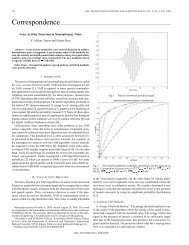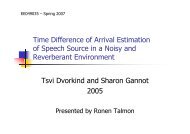Thesis (PDF) - Signal & Image Processing Lab
Thesis (PDF) - Signal & Image Processing Lab
Thesis (PDF) - Signal & Image Processing Lab
Create successful ePaper yourself
Turn your PDF publications into a flip-book with our unique Google optimized e-Paper software.
72 CHAPTER 5. TREE SEMILATTICES<br />
same vertex set of the RAG - a set of all flat zones in the image. In that sense, the<br />
BTV tree is a particular case of a spanning tree.<br />
The shape tree is defined in [20] and the resulting semilattice is defined in [17].<br />
The shape tree differs from the BTV tree in one main aspect: its vertex set is not<br />
the flat zones of the image. Its vertex set is built from the flat zones during the tree<br />
generation. Each father vertex area includes all sons in addition to an area of itself.<br />
For each point in the image there may be more than one vertex in the shape tree that<br />
includes that point. In order to preserve the single value of the mapping function we<br />
define a mapping to the biggest vertex of all possible vertices in the tree.<br />
Max and Min Trees<br />
Another group of trees is Max and Min trees. Those trees, as described in sec-<br />
tion 2.2.1, are created from the RAG, sorted by the gray level of the flat zones.<br />
Similar to the above shape tree, each vertex region in the picture contains all children<br />
vertices. In Max Tree the father gray level is always bigger than the son. And, of<br />
course, the opposite in a Min tree. When a father is always brighter/darker then a<br />
son, the infimum operation always changes the gray level to the darker/brighter side.<br />
This has the same effect as a regular erosion on a gray-level picture. For this reason<br />
those trees are of no special interest for the proposed approach.<br />
5.3 Semilattice of <strong>Image</strong>s<br />
5.3.1 Structure Induction<br />
What we would really like is the complete inf-semilattice of tree representation (using<br />
a tree τ) to induce a complete inf-semilattice in the image domain. That is, we<br />
would like, for instance, that the composite operation of τ −1 ετ be an erosion in the<br />
image domain. However, that is not guaranteed; for some tree transforms τ an image<br />
semilattice is obtained and for others not. In fact, the partial ordering in the tree-<br />
representation domain does induce a partial ordering for images, for any τ; however,<br />
the infimum is not guaranteed to exist.<br />
Let f be an image, τ(f) is a tree representation. Tε = ε(τ(f)) is the tree repre-<br />
sentation of an erosion operator result. Let fε = τ −1 (ε(τ(f))) be the image obtained
















